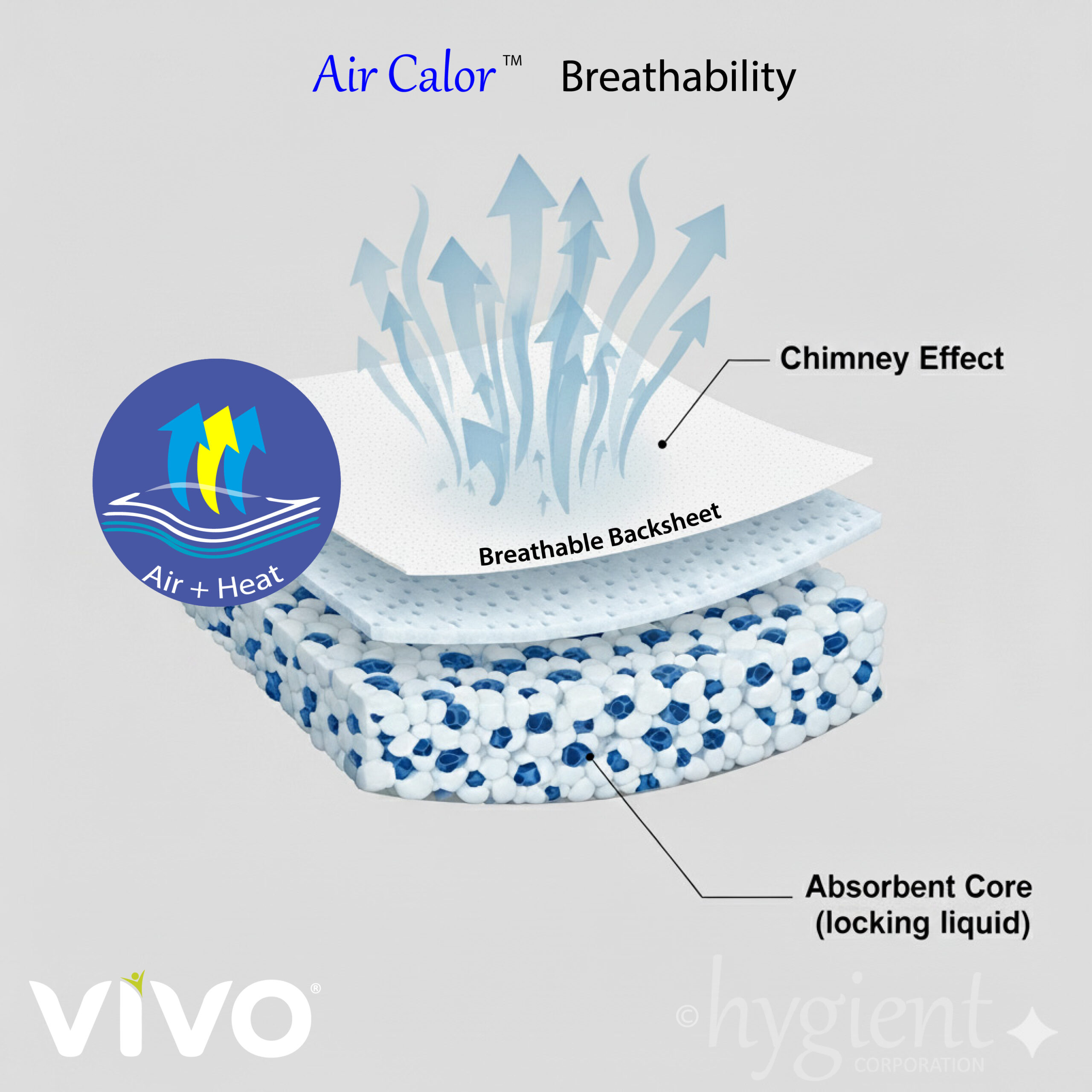
A Review of the Scientific and Clinical Evidence on the Efficacy of Breathable and High-Absorbency Disposable Diapers in Mitigating Skin Conditions
Abstract:
This report synthesizes findings from clinical trials and academic publications to review the impact of breathable and high-absorbency disposable diapers on skin health. The central principle behind this advanced diaper technology is the combined use of a microporous backsheet and a high-capacity superabsorbent core. This design innovation directly addresses the primary causes of diaper dermatitis: skin overhydration, elevated pH, and increased friction. A review of the literature demonstrates that these diapers create a less occlusive microenvironment and effectively manage moisture, significantly reducing the prevalence and severity of diaper rash and other moisture-related skin issues. The evidence provides a strong basis for the use of these materials as a key strategy in the prevention and management of diaper-related skin conditions.
Details:
1. The Scientific Principle of Diaper Breathability
Traditional disposable diapers are designed with a non-porous outer layer (backsheet) to prevent leaks, which inadvertently creates a sealed, occlusive environment. This traps moisture and heat against the skin, leading to several negative effects. The trapped water vapor causes skin overhydration, weakening the skin’s barrier function and making it more susceptible to damage from friction. The moist environment also raises the skin’s pH, altering the natural acid mantle and promoting the growth of microorganisms, such as Candida albicans, which are a common cause of fungal diaper rash.
Breathable disposable diapers counteract this by incorporating a microporous backsheet. This layer is composed of a material that has microscopic pores small enough to prevent the passage of liquid urine but large enough to allow water vapor (in the form of sweat and humidity) to escape. This process is known as “vapor permeability.” By facilitating the release of moisture, breathable diapers maintain a drier, cooler microclimate in the diaper area, which is essential for healthy skin.
2. Clinical Evidence for Improved Skin Health
Multiple clinical studies have documented a direct link between the use of breathable diapers and a reduction in the incidence and severity of diaper dermatitis [7].
- Reduced Diaper Dermatitis: A double-blind, randomized clinical trial published in a reputable medical journal found that infants wearing highly breathable diapers experienced significantly less diaper dermatitis compared to those using standard, non-breathable diapers [7]. The prevalence of diaper rash was found to be inversely related to the breathability of the diaper [3].
- Mitigation of Fungal Infections: The same study demonstrated that severe diaper dermatitis, including confirmed infections with Candida albicans, was reduced by 38-50% among infants wearing breathable diapers. This is due to the drier environment, which is less conducive to the proliferation of yeast. Controlled experiments with adult volunteers further confirmed that the survival of Candida colonies was reduced by nearly two-thirds in sites covered by breathable diaper materials compared to non-breathable ones [7].
Figure 1: A conceptual diagram illustrating the “chimney effect” of a breathable diaper’s microporous backsheet.

The illustration shows how moisture vapor is released through the pores of the backsheet, effectively cooling the skin and maintaining its integrity.
3. Application to Adult Incontinence and Bed-Bound Patients
The principles of skin health and breathability demonstrated in pediatric care are equally relevant and, in many cases, even more critical for adults with incontinence, particularly for bed-bound or immobile seniors. These individuals are at a high risk for developing Incontinence-Associated Dermatitis (IAD) and pressure ulcers due to prolonged contact with moisture, friction from movement, and reduced skin integrity associated with aging [9].
- Parallel Conditions: IAD in adults is the equivalent of diaper dermatitis in infants. Both are forms of moisture-associated skin damage caused by a compromised skin barrier and an alkaline microenvironment from prolonged exposure to urine and/or feces. Studies have shown that a skin-adapted brief design with breathable side panels and an acidic surface pH can significantly reduce skin overhydration and lead to the resolution of existing IAD lesions.
- Criticality for Extended Use: For bed-bound patients who wear incontinence products for extended hours, the risk of skin breakdown is significantly elevated. Breathable products are essential as they prevent the buildup of heat and moisture, which is a key contributor to maceration—the softening and weakening of the skin. By allowing moisture vapor to escape, these products help maintain the skin’s natural acidic pH and improve its resistance to friction and bacterial growth [6]. A study on absorbent underpads found that air-permeable layers and a high moisture vapor transfer rate are critical performance factors that help promote optimal skin health in long-term care settings [8].
4. The Role of High-Absorbency Cores in Overnight and Extended Use Diapers
While breathability addresses moisture vapor, a high-capacity absorbent core is essential for managing the liquid waste itself, particularly during extended periods like overnight use. These cores are typically made from a blend of cellulose fluff and superabsorbent polymers (SAPs). When they come into contact with urine, the SAPs quickly absorb the liquid and transform it into a gel, effectively locking it away from the skin.
This wicking and locking mechanism serves a dual purpose: it keeps the skin’s surface dry and helps to maintain the product’s overall integrity, preventing the saturation of the top sheet and reducing the risk of leaks. For bed-bound patients, this is a crucial feature that minimizes the need for frequent changes and reduces the potential for skin contact with urine over long periods. When a high-absorbency core is combined with a breathable backsheet, the product provides a holistic solution: the core manages the liquid load, and the backsheet manages the vapor and heat, creating an ideal microclimate for skin health.
5. Key Benefits to Skin
The scientific and clinical findings lead to several clear benefits for skin health when using breathable diapers:
- Reduced Overhydration: By allowing excess moisture to evaporate, the skin remains at a more natural hydration level, preventing the maceration that weakens the skin barrier.
- Improved Skin pH: A drier environment helps to maintain the skin’s slightly acidic pH (4.5-5.5), which is crucial for protecting against irritants and pathogens.
- Less Friction and Chafing: Hydrated skin has a higher coefficient of friction. By keeping the skin dry, breathable diapers reduce the likelihood of mechanical damage from rubbing.
- Decreased Microbial Growth: The lower humidity and more balanced pH in the diaper area create an unfavorable environment for the growth of bacteria and fungi, thereby reducing the risk of infection [7].
6. VIVO Adult Incontinence Products: The SCIENCE Backed Choice for Seniors
Based on the evidence presented, VIVO adult incontinence products are an ideal choice for seniors, particularly those at elevated risk for IAD and skin breakdown. The product’s key features align perfectly with the principles of skin health management discussed in this report:
- Fully Breathable: The use of a breathable backsheet ensures that moisture vapor and heat are not trapped against the skin, maintaining a healthy microclimate and preventing the maceration that is a key contributor to IAD.
- High Overnight Absorbency Core with up to 12-Hour Usage: This feature directly addresses the critical need for moisture management during extended wear, such as overnight. The high-capacity core with Superabsorbent Polymers (SAPs) effectively wicks and locks away liquid, keeping the skin dry and reducing the risk of prolonged contact with urine. This minimizes the need for disruptive overnight changes for both patients and caregivers.
- Organic Cotton Enriched Skin Contact Lining: The presence of a soft, cotton-enriched top sheet minimizes friction against fragile skin. This is especially important for bed-bound or immobile individuals who may experience constant rubbing.
- Hypoallergenic: VIVO products are hypoallergenic as is strongly supported by their composition. By being Latex-Free, Lotion-Free, Chlorine-Free, Unscented, and containing No toxic additives or harsh chemicals, they eliminate many of the common allergens and irritants known to cause contact dermatitis and other skin sensitivities [2]. This makes them a safe and gentle option for individuals with delicate or compromised skin [10, 11].
The combination of a breathable design, a high-capacity core, and a skin-friendly, hypoallergenic formulation makes VIVO products a comprehensive solution for promoting and protecting skin health in at-risk adult populations [11]. The fact that they are “physician recommended” further validates their effectiveness and safety from a clinical standpoint.
7. Conclusion
The body of scientific evidence overwhelmingly supports the use of breathable disposable diapers as a superior choice for promoting and maintaining skin health [1, 5]. By preventing the occlusive effects of traditional diapers and effectively managing liquid waste with high-absorbency cores, these products directly address the root causes of diaper dermatitis and related skin issues. This technology is a critical component of modern incontinence and baby care product design, providing a well-documented and effective means of preventing common skin problems in vulnerable populations. The same principles of breathability and microclimate management are vital in adult care, where they are a key strategy for the prevention and management of IAD, particularly for bed-bound individuals.
References:
- A. S. L. C. P. Diapers, Diaper Dermatitis, AGM, Skin Health – Child Health Nursing Research.
- Federal Trade Commission. “FTC’s Advertising FAQ’s: A Guide For Small Business.” www.ftc.gov/business-guidance/advertising-marketing/advertising-faqs
- Uyanik, S., & Kaynak, H. K. (2018). A comparative study on the performance properties of breathable and non-breathable baby diaper back sheet. Technical Journal, 12(2), 74-78.
- Zimlich, R. (2021). Cloth diapers: Are they the answer to less diaper rash? Contemporary Pediatrics.
- Diaper Answers. “Clinical Studies & Consumer Data.” www.diaperanswers.org/diaper-safety-health/clinical-studies-consumer-data/
- Huggies Healthcare. “Benefits of Breathable Disposable Diapers.” www.huggieshealthcare.com/en-us/education-and-research/skin-health/disposable-diapers/benefits
- C. P. (2008). Effects of Breathable Disposable Diapers: Reduced Prevalence of Candida and Common Diaper Dermatitis. Pediatric Dermatology, 18(4), 282-290.
- Cardinal Health. “The impact of an absorbent underpad on pressure ulcer and incontinence-associated dermatitis rates in long-term care settings.” https://www.cardinalhealth.com/content/dam/corp/web/documents/case-study/cardinal-health-incontinence-underpads-LTC%20Study_Motta.pdf
- E. S. (2010). Improving diaper design to address incontinence associated dermatitis. ResearchGate.
- HomeCare Magazine. “Incontinence & Wound Prevention.” https://www.homecaremag.com/senior-care-products/incontinence-wound-prevention
- VIVO Adult Incontinence Products. www.vivocare.us
